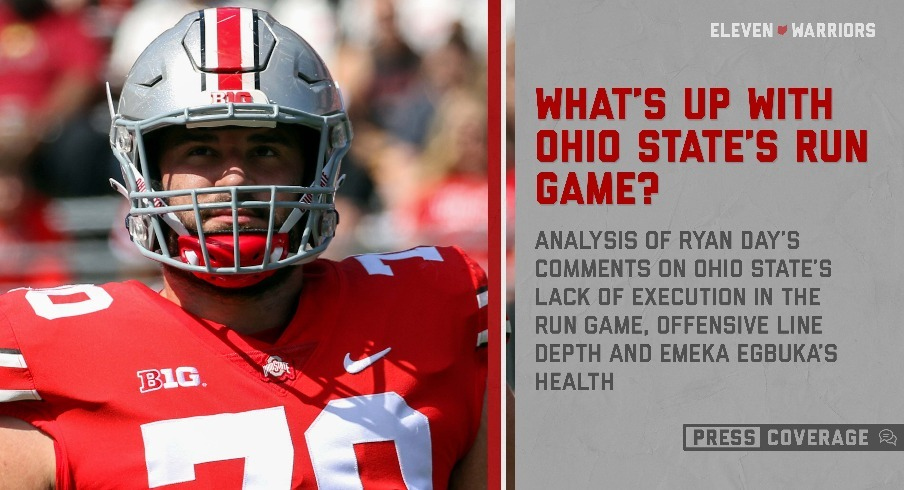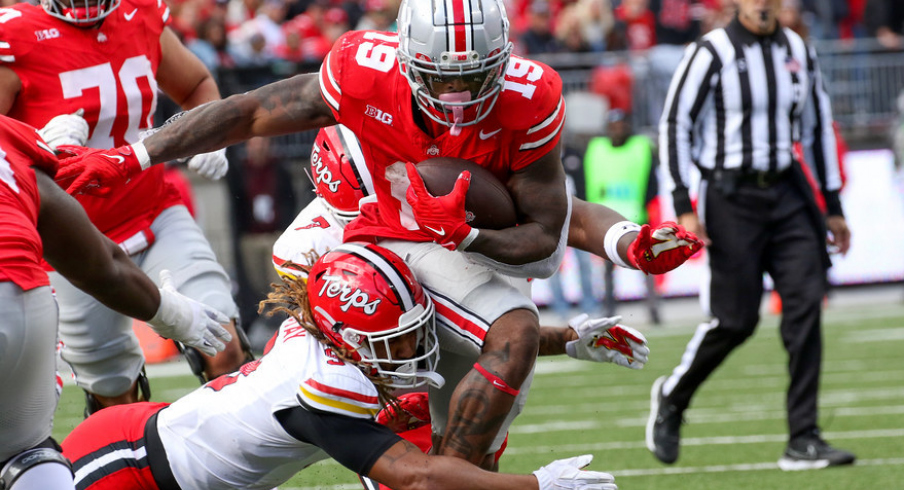It's not just a short-yardage issue.

Ohio State is 5-0, coming off a 20-point victory over a previously undefeated Big Ten opponent, ranked third in both major polls, fourth in SP+, and ranks in the top 10 in both yards and points allowed. If you had told me ahead of the season that supporters of the Scarlet and Gray were freaking out right now, I would have surely shaken my head and spewed some four-letter words about the fanbase's unrealistic expectations.
As regular readers of Film Study will (hopefully) tell you, we try to be objective in this space, taking the hot air out of many arguments and providing calm-bordering-on-sterile analysis.
...
But the Buckeye run game is a
real problem.
Despite all the lofty rankings listed above, one that can't be ignored is the fact that just
four teams in FBS have fewer runs of 10+ yards than Ohio State does through nearly half the season.
Questions arose after underwhelming performances against Indiana and Youngstown State, but gaining 204 rushing yards on Western Kentucky seemed to show that an offensive line with three new starters had found some chemistry. One week later, TreVeyon Henderson's 61-yard touchdown run overshadowed an otherwise disappointing night on the ground, as the visitors averaged just over two yards on all other carries inside Notre Dame Stadium.
It was a Maryland run defense that now ranks 27th nationally which showed that not only does Ohio State still have issues running the football on 3rd-&-1, but on 1st-&-10 as well. The Buckeyes probably didn't expect to have so much trouble running on a unit that surrendered 4.3 yards per carry to Towson in its season opener, even without Henderson in the lineup.
But the Buckeyes didn't tally just 62 yards on 33 carries because Chip Trayanum was the starter. Rather, it was a fundamental issue with the blocking that allowed the Terps to erase almost every one of his attempts.
Most OSU fans know that the run game is built around wide and mid-zone runs, aiming to hit the C or D gaps with a chance of cutting the ball back inside when the defense overplays the scheme. But while zone-blocking theoretically allows any play to be successful, given its simplicity, it only works when the players execute it properly.
Against Maryland, that simply wasn't happening.
Ryan Day and Justin Frye are both noted pupils of Chip Kelly,
who has long taught zone-blocking to his linemen by assigning numbers to defenders rather than learning countless defensive fronts. While it's not confirmed that this is still being taught inside the Woody Hayes Athletic Center in 2023, there's little reason to believe otherwise.
In this system, the center identifies the player for which he will be responsible and assigns him the number 0. From there, the play-side guard's man becomes the next defender outside, regardless if it's a down lineman or a linebacker, and gives him #1 while the tackle takes #2, and the tight end #3...........
It's not as if the players themselves aren't capable, though. Despite the run game struggles, the OSU offensive line has been solid in pass protection, with five of its seven sacks allowed this season coming on plays in which McCord simply held the ball too long.
But unless Day, Frye, and the rest of the offensive staff show they can fill the gap left by the loss of Wilson and his decades of experience, no amount of effort will make up for what plagues the Ohio State running game at this point. While this Saturday's opponent, Purdue, ranks just 85th in the nation when it comes to stopping the run, Penn State and its sixth-ranked such unit is looming on the horizon.
Ohio State's O-line continued to have trouble executing basic zone-blocking principles, leaving Maryland linebackers unblocked and runners with nowhere to go.

www.elevenwarriors.com






